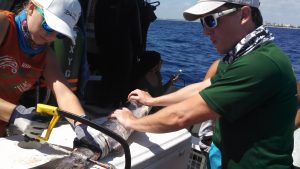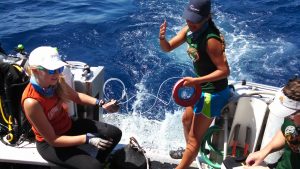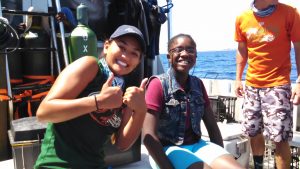Shark Tagging with Lauderdale Lakes
by Hanover Matz, RJD intern
May 13th, 2015. The sea was angry that day, my friends. Well, not quite angry-but the swells were a bit more than we usually bargain for. However, that did not stop the RJD team and the students from Lauderdale Lakes from having a fantastic day of shark tagging. We met at Jim Abernethy’s Scuba Adventures for an exciting day out on the M/V Shear Water. As we loaded the gear onto the boat, we added extensions to our drumlines for deep water fishing offshore, hoping to catch a variety of shark species. The RJD team briefed the students on the protocols we would use for research. Each drumline has a circle hook that safely hooks in the jaw of the sharks, and the monofilament fishing line is attached to a swivel at the base to allow the sharks to continuously swim while hooked. From each shark, the students would help us collect a variety of samples including a nictitating membrane test and length measurements.

RJD interns cut up a barracuda to use as bait. A variety of fish species are used as bait to catch sharks
We quickly deployed ten lines from the stern of the boat, and then left the lines in the water for a standardized 1 hour soak time. During this interval, we collected environmental measurements including water temperature, salinity, and dissolved oxygen concentration. These measurements provide valuable insight towards the different habitats and conditions local shark populations encounter. After collecting this data, we returned to collect our lines and to see if we had caught any sharks.
Our first shark of the day was a large female nurse shark. Nurse sharks are a species that is frequently caught on our tagging trips. Weather conditions made it a bit choppy down on the platform, but the RJD team quickly brought the shark in and secured it for a work up. Nurse sharks differ from other species of sharks in that they lack a nictitating membrane, and are capable of pumping water over their gills without swimming via buccal pumping. These sharks are quite hardy. Length measurements were taken, as well as a fin clip sample. Tissue samples can provide data about the shark’s diet by using a technique known as stable isotope analysis. After the work up was finished, we released the shark safely into the water.
The day would prove to be very eventful. Our next shark was another a nurse, also a female. Male and female sharks can be differentiated by the pair of clasper organs the males have just behind the pelvic fins. We quickly tagged and collected data from the shark, and then released it off of the stern. Next, we caught a female bull shark. Bull sharks can be found in both shallow and deep water along the Florida coast, and have even been known to spend time in brackish and freshwater. We collected a blood sample from the shark which can be used to study the shark’s diet, health, and even determine if it is pregnant. Blood samples can be separated into the red portion containing red blood cells, and the clear portion known as plasma for further analysis.
The waves kept coming, and the sharks kept biting. It was not long before we had another bull shark on the line. Our fourth female shark of the day, we secured the bull shark for the research work up. Unlike nurse sharks, bull sharks do have a nictitating membrane. By shooting a quick jet of water into the shark’s eye, we can determine whether or not the nictitating membrane is firing. A protective translucent eyelid, the nictitating membrane is an involuntary reflex that guards the shark’s eye when it is feeding or biting unknown objects. If it fires, we know that the shark is in relatively good condition. After measuring the shark and collecting a fin clip, a dart tag was inserted at the base of the dorsal fin. This tag has a specific identification number and the lab’s phone number; if the shark is ever recaptured, we can gain valuable data on its movement patterns and growth.
On a normal tagging trip, we usually set 30 lines in total (10 per set), but this day was so busy we only reset 5 lines for a total of 15. Weather conditions also made it a bit difficult to remain out on the water. The last 5 lines did not disappoint: our last shark of the day was a female Caribbean reef shark. Caribbean reef sharks are not a species we typically encounter on an average trip. This makes any data we collect from such individuals very valuable. Like the other sharks, the RJD team and Lauderdale Lakes students measured, tagged, and took blood and fin clip samples from the reef shark before releasing her back into the water. All in all, 5 sharks on 15 lines made for a very successful day of tagging. Hopefully we will be back to the West Palm area in the future for more important conservation research.


